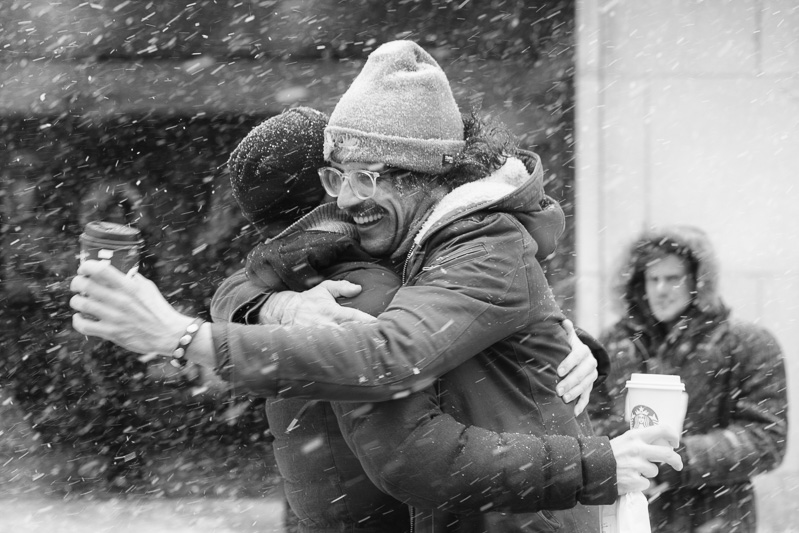Yesterday, Toronto saw a record-breaking snowfall. Naturally, I spent the day outside enjoying the photographic opportunities these conditions offer. To begin, I took a turn down Ted Rogers Way and saw a man approaching with fresh pressed shirts slung over a shoulder. I recognized the man, then remembered why. On the weekend, he had led a workshop for the board of directors of the choir with whom I sing. I don’t serve on the board of directors, but I sat in on the workshop. I said hello and he responded with a perfunctory smile that conveyed quite clearly he had no idea who I was. The context was all wrong. It was snowing. I was wearing a geeky aviator’s hat that obscured my face. Of course he had no idea who I was. There, amongst the towering condo and apartment buildings, we squandered the faintest glimmer of recognition and passed each other by as strangers.
For the next two hours, I took a meandering course downtown where I passed hundred of people by as strangers. It’s sad to think I can spend two hours wandering the streets of my hometown and recognize no one (except, of course, the man carrying his fresh pressed shirts who didn’t recognize me). At the same time, it is precisely this anonymity that makes street photography possible. It is my cloak of invisibility and it allows me to enter scenes without notice. But not everyone shares my invisibility.

Two hours later, it was time for lunch and I was heading home. I stood on the southwest corner of Church and Carlton, across from Maple Leaf Gardens, waiting for the light to change. The snow continued to fall in fluffy chunks. On the road, the snow was slushy and turning dirty. When the light changed, I hesitated. Ironically, it was this hesitancy that garnered me the best shot of the morning. A man carrying a coffee cup stepped around me and onto the street. On the far curb, another man carrying a coffee cup called out to the first, a chance encounter between old friends. I could tell by the way they cried out to one another, the happiness in their voices, the way they carried themselves, that an embrace was inevitable. By the time they met in the middle of the street, I had raised my camera and had the scene in focus. I took a short burst of four exposures, but the first was the only viable shot: the face, the smile, the coffee cups, the onlooker. I lowered my camera and passed them by. In a second I was gone.
I take the most satisfaction from making this kind of image. The elements of the image present themselves for only a few milliseconds and I must be prepared to seize the moment. Through anticipation, instinct, and reflexes, I respond to the encounter. When all the elements converge, as I believe they did in this instance, it feels to me like a moment out of time.
My personal detractor, the one who natters inside my head, tells me it’s not possible that this could be a good image. The entire transaction, from my anticipation of the moment to my disappearance in the crowd, took no more than three seconds; everybody knows that one’s craft requires work, especially work that involves suffering; there is no reward without effort. But my personal detractor fails to understand that photography is not a craft; photography is a religion. It is governed by a theology of grace. We do not earn our good images; they are bestowed upon us.